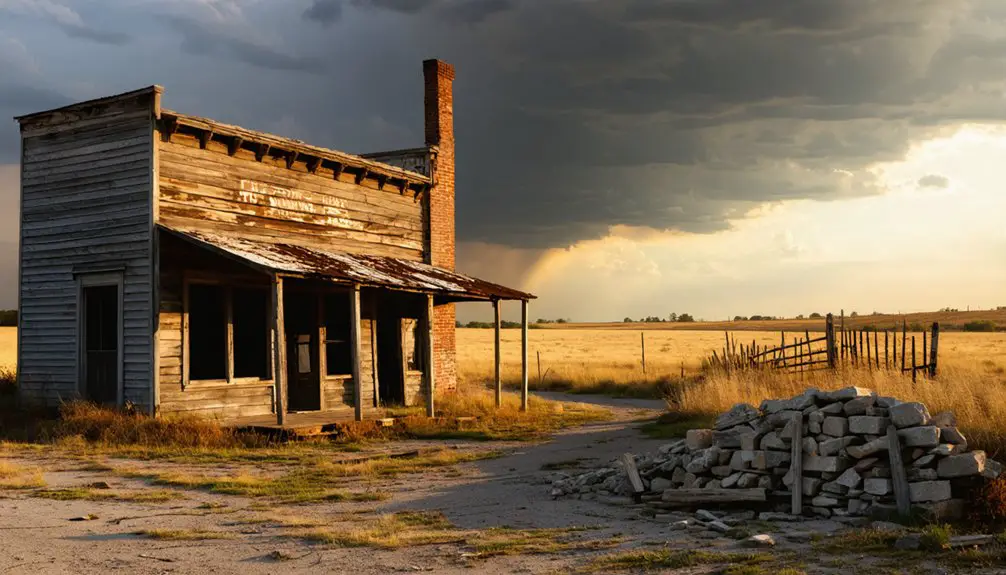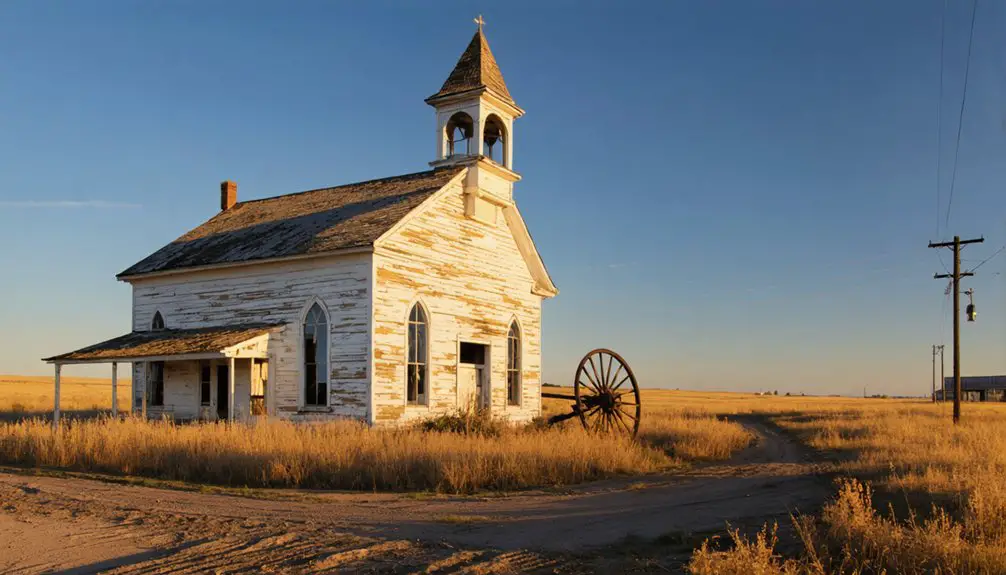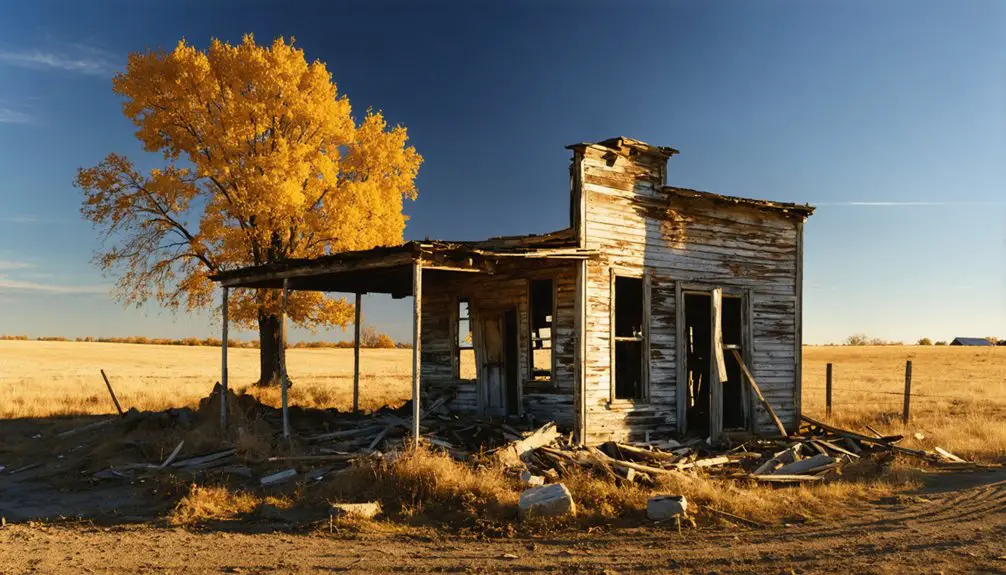You’ll find Cofachiqui at 37.9333°N, 95.4148°W, where Allen County’s first settlement emerged in 1855 as a pro-slavery stronghold. Named after a benevolent Osage chief, the town briefly served as county seat with James Galbreath’s store and Richard J. Fuqua’s trading post anchoring local commerce. Poor well-water and competition from anti-slavery Humboldt and Iola led to its abandonment by the early 1860s, leaving buried traces beneath modern farmland that tell a complex frontier tale.
Key Takeaways
- Cofachique, established in 1855 as Allen County’s first settlement, became a ghost town by the early 1860s due to economic decline.
- Poor well-water sources, difficult terrain, and competition from anti-slavery settlements in Humboldt and Iola led to Cofachique’s abandonment.
- In 1859, most residents and businesses relocated to Iola after losing the county seat status, leaving Cofachique virtually deserted.
- The settlement’s pro-slavery stance conflicted with the region’s anti-slavery sentiment, contributing to its eventual downfall.
- Located at 37.9333°N, 95.4148°W, few visible traces remain of Cofachique today, with most artifacts buried beneath converted farmland.
The Birth of Allen County’s First Settlement
While Kansas Territory was still embroiled in pre-Civil War tensions, Cofachique emerged as Allen County’s first settlement in the summer of 1855.
You’ll find that this pioneering town, established by pro-slavery settlers, quickly gained prominence as the county seat by September of that same year.
The Cofachique community dynamics were complex from the start, as the town’s pro-slavery stance contrasted sharply with the region’s mostly anti-slavery sentiment. By 1857, declining population numbers forced the county seat to relocate to the growing town of Iola.
The settlement’s early governance took shape when Mr. Barbee, the first settler on the town site, became County Clerk in May 1856.
Though positioned along the Neosho River, you’ll notice the town’s founders chose a hilly location that made water access challenging – a decision that would later contribute to the community’s decline as settlers looked elsewhere for more practical locations. Like the Osage Indians who first settled Kansas, the early residents relied heavily on trading posts for survival.
Origins of the Town’s Native American Name
The story behind Cofachique’s name connects this Kansas settlement to a rich Native American heritage spanning from South Carolina to the central plains. The etymology traces back to both the Cofitachiqui tribe of South Carolina and an Osage chief named Cofachique who aided early Kansas settlers.
You’ll find fascinating Native connections through the Siouan language family, which links these seemingly distant communities. The tribe was known for their beautiful female chief who initially welcomed Spanish explorer Hernando de Soto in 1540.
- The name originated with the Cofitachiqui people, a Siouan-speaking tribe from South Carolina’s river regions.
- The Osage people, who settled in Kansas, shared Siouan linguistic roots with the Cofitachiqui.
- Chief Cofachique, an Osage leader known for helping settlers, became the town’s namesake.
The settlement was established as the first town in Allen County in 1855, marking the beginning of organized communities in the region.
This naming pattern reflects the complex relationships between Native Americans and settlers during Kansas’s early development, preserving Indigenous heritage through place names.
Chief Cofachique’s Legacy of Benevolence
As one of the most influential Native American leaders in early Kansas settlement history, Chief Cofachique earned lasting recognition through his compassionate aid to struggling pioneers along the Neosho River valley.
You’ll find that Cofachique’s kindness became legendary among settlers, as he provided refuge and assistance to homeless families trying to establish themselves in the challenging frontier environment.
His approach to Native American diplomacy helped forge peaceful relationships between the Osage people and newcomers, creating a foundation of goodwill that influenced the early development of Allen County.
Chief Cofachique’s diplomatic wisdom built bridges between the Osage and settlers, fostering lasting harmony in Allen County’s early years.
The first post office along this frontier opened in spring 1855 at the town site that honored his name.
While the town that bore his name later became entangled in pro-slavery conflicts, Chief Cofachique’s legacy of benevolence transcended political divisions, remaining a powerful symbol of cooperative spirit in Kansas’s frontier history. The settlement ultimately met its end when Free State legislature moved the county seat to Humboldt in 1858.
Life Along the Neosho River
Living along the Neosho River near Cofachiqui presented you with a mix of opportunities and hardships, as the river’s seasonal flooding patterns could disrupt settlements while providing essential resources. The river’s flow could reach up to 133,000 cubic feet per second during peak periods.
You’d find yourself adapting to the humid continental climate‘s impact on the river, where spring floods could transform peaceful waters into destructive forces that threatened crops and buildings. With approximately 38 inches of annual rainfall, these floods were a regular concern for settlers.
During calmer periods, you’d join other settlers in fishing the river’s abundant waters, where the 194-day growing season allowed for sustained fishing activities from spring through early fall.
River Settlement Challenges
Situated along the unpredictable Neosho River, settlers in Cofachiqui faced recurring challenges from devastating floods and overflow risks throughout their occupation.
Despite the fertile alluvial soil‘s promise, you’d have found flood management a constant concern, especially after the first major flood in June 1869.
The anti-slavery settlers who populated the area faced these environmental challenges while maintaining their strong Union stance during the Civil War period.
The deep, nutrient-rich black limestone soil near the river made the flood risks worth enduring for many determined farmers.
The river’s changing nature created additional hardships for early residents:
- Inaccurate land surveying led to confusion over property boundaries, with cabin locations sometimes ending up in different sections than their wells.
- The shifting course of the Neosho and its tributaries complicated mapping efforts.
- Natural features often conflicted with official section lines, creating uncertainty in land ownership.
You’d have needed to adapt continually to these challenges, building homes with flood mitigation in mind while traversing the complex terrain of property rights.
Seasonal Fishing Activities
While settlers wrestled with the Neosho River’s flooding challenges, they’d discover its rich fishing opportunities, particularly during the annual paddlefish snagging season from March 15 through May 15.
You’d need to follow strict paddlefish regulations, including a daily limit of two fish and a seasonal cap of six. During ideal conditions, when river flows hit 10,000 to 15,000 cubic feet per second, your chances of success would increase considerably.
Beyond paddlefish, you could catch various species year-round, including catfish, white bass, and walleye.
The Chetopa area, with its well-maintained access points and local bait shops like Riverside Sporting Goods, would become a hub for seasonal fishing activities.
You’d find the Chetopa Dam especially productive for both paddlefish and catfish.
The Rise and Fall of a Pioneer Town

Founded in 1855 as Allen County’s first town and county seat, Cofachique emerged from the Kansas Territory’s pro-slavery movement with ambitious plans for dominance. The pioneer challenges faced by settlers were immense, as they tried to establish a Cofachique economy in the hilly terrain near the Neosho River.
- Pro-slavery pioneers from Fort Scott established the settlement with support from Territorial Secretary Daniel Woodson.
- The town’s location suffered from poor well-water sources and difficult terrain.
- Competition from anti-slavery settlements in Humboldt and Iola created mounting political tensions.
You’ll find that Cofachique’s decline was swift. By 1859, most businesses and residents had relocated to newly-founded Iola.
The town’s complete abandonment before the Civil War marked the end of this pro-slavery stronghold, with even its township name eventually changed to erase its legacy.
From Bustling County Seat to Abandoned Fields
When you look at Cofachiqui’s brief reign as Allen County’s first seat of government in 1855, you’ll find a pioneer settlement that couldn’t maintain its initial promise.
You’ll see how within just five years, most residents and businesses had relocated to the newly established town of Iola, which offered better economic prospects and transportation connections.
The town’s rapid decline from county seat to abandoned settlement reflects a common pattern in 19th-century Kansas, where emerging communities often competed for regional dominance, leaving ghost towns in their wake.
Early Settlement Years
As Richard J. Fuqua staked his claim in January 1855, he launched settlement dynamics that would shape Allen County’s future.
You’ll find that Cofachique quickly emerged as the county’s powerhouse, designated by legislative act as the permanent county seat and staked out that summer.
Trade relationships flourished as the town took root, particularly through:
- James Galbreath’s pioneering store opening
- Heavy commerce with neighboring Indian tribes
- Additional merchants like H.D. Parsons & Mr. Lynn establishing shops
You won’t find early postal service in Cofachique’s first years – citizens hired their own mail carrier until 1857.
As the only town in Allen County for its first two years, Cofachique dominated regional trade, drawing settlers and tribes alike to its bustling marketplace.
Lost to Iola’s Rise
Despite Cofachique’s early dominance as Allen County’s first town and county seat, its prominence rapidly faded in the late 1850s once Iola emerged as a competing settlement.
You’d have witnessed Cofachique’s decline as residents and businesses steadily migrated to Iola, drawn by its strategic location and better transportation prospects.
Iola’s advantages proved insurmountable for Cofachique. While Cofachique struggled with limited river navigation and poor road infrastructure, Iola flourished along emerging railroad lines.
Within just five years, you’d have seen the county seat relocate to Iola, dealing the final blow to Cofachique’s relevance.
By the early 1860s, the once-bustling settlement had become a ghost town, its buildings either dismantled or left to decay.
The site’s transformation into farmland marked the end of Cofachique’s brief chapter in Kansas history.
Relocation to Iola: A Community’s Exodus

Through a remarkable community exodus in 1859, most of Cofachiqui’s residents and businesses relocated to the newly established town of Iola, situated just one and a half miles northeast. This mass migration pattern reflected the shifting community dynamics of Kansas Territory during the pre-Civil War period.
In 1859, an entire Kansas town picked up and moved, as Cofachiqui’s people abandoned their homes for nearby Iola.
The relocation wasn’t just about moving buildings – it represented a profound shift in regional power and ideology:
- A town company formed by citizens from multiple communities purchased land from Josiah Colborn.
- Businesses and residents abandoned Cofachiqui’s pro-slavery legacy for Iola’s fresh start.
- The new settlement was named after Colborn’s wife, marking a clean break from the past.
You’ll find that this exodus effectively ended Cofachiqui’s influence, as Iola quickly established itself as the region’s dominant community and secured its position as the county seat.
Archaeological Traces and Geographic Markers
Located along the Neosho River near modern-day Iola in Allen County, Kansas, Cofachique’s archaeological footprint remains largely unexplored at coordinates 37.9333°N, 95.4148°W.
The site’s cultural heritage faces preservation challenges, as farmland conversion has limited extensive archaeological studies. You’ll find few visible traces of the original settlement, though material culture from the 1850s may lie beneath the surface.
The town’s name honors an Osage chief and shares linguistic roots with the Cofitachiqui tribe of South Carolina, reflecting the area’s rich Native American heritage.
While the site’s archaeological preservation remains minimal, you can still spot faint traces of old roads, property boundaries, and nearby church and cemetery structures that mark this once-thriving frontier settlement along the fertile river floodplain.
Historical Significance in Kansas Settlement

As a pivotal frontier settlement, Cofachique emerged in 1855 as Allen County’s first established town and original county seat, marking a significant milestone in Kansas’s territorial development.
You’ll find its legacy deeply rooted in the region’s early administrative and cultural foundations, where the settlement’s strategic location along the Neosho River shaped initial agricultural prospects.
- Named after an Osage chief who aided settlers, reflecting the essential Native American alliances
- Served as a prototype for frontier governance, though few historical artifacts remain
- Shifted to primarily Cofachique agriculture land after most residents moved to Iola
Despite its brief prominence, Cofachique’s establishment and rapid decline illustrate the dynamic nature of frontier settlements.
Within just five years, the town’s influence waned as nearby Iola emerged as the region’s dominant center, demonstrating the fluid patterns of early Kansas development.
Frequently Asked Questions
What Was the Population of Cofachique at Its Peak?
You’ll find the ghost town demographics show a peak population of over 1,000 residents, though population trends indicate this lasted briefly before most settlers moved to nearby Iola around 1860.
Were There Any Notable Crimes or Incidents During Cofachique’s Brief Existence?
Like a blank page in history’s book, you won’t find any documented crime statistics or notable incidents during the town’s short life from 1855-1860 before its relocation to Iola.
What Types of Businesses and Industries Operated in Cofachique?
You’d have found basic frontier businesses like a post office, saloon, general stores, and schoolhouse. Agricultural practices dominated the economy, but there weren’t any significant mining operations in the area.
Did Any Natural Disasters Contribute to Cofachique’s Abandonment?
Like a mirage in the desert, you won’t find evidence of tornado impacts or flood damage driving Cofachique’s demise. Records show it faded due to economic shifts and Iola’s rise instead.
What Happened to the Original Buildings When Residents Moved to Iola?
You’ll find no building preservation occurred – the structures were either moved, dismantled, or left to decay. Without maintenance, their historical significance faded as the land transformed into farmland within five years.
References
- https://en.wikipedia.org/wiki/Cofachique
- https://www.youtube.com/watch?v=cF4Q0P5CBis
- https://www.hhhistory.com/2019/05/ghost-towns-of-kansas.html
- https://porzucki.com/Treece-KS-Ghost-Town-in-the-Making
- https://legendsofkansas.com/kansas-ghost-town-list/
- https://ozarkscivilwar.org/regions/allen
- https://www.coffeyville.com/343/Early-Area-History
- http://www.kancoll.org/books/cutler/coffey/coffey-co-p1.html
- https://legendsofkansas.com/coffey-county-kansas/
- https://www.nativehistoryassociation.org/cofitachequi.php



